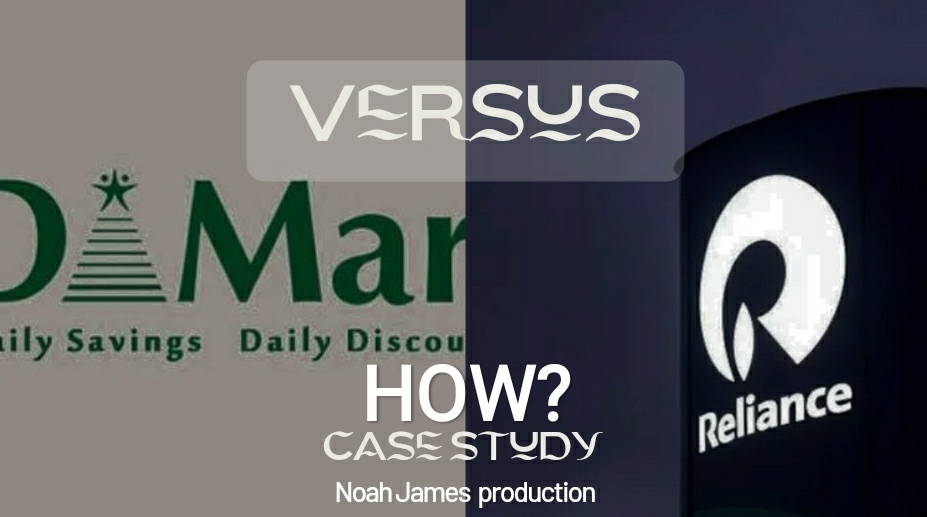Will DMart Beat Reliance?
Will DMart defeat Reliance and Amazon
Case study
DMart uses a very powerful psychological trick in addition to price, To beat Reliance and Amazon. In this article you need to understand 3 strategies, to understand it.
There is only one company that competes with DMart and that is Reliance Retail. In the year 2020, Reliance retail earned revenue of Rs 1.63 lakh crore. Which is 6 times the revenue of DMart. But within a year, DMart benefited its investors with a profit that more than doubled. One year ago, the stock which was Rs 2,100 hit Rs 5,300 on 14th October. So at last, what is DMart doing differently that even Reliance and Amazon can't do? And aside from pricing, what are those secret business strategies that DMart uses? To compete with companies like Amazon and Reliance. And most importantly, what are those business lessons that we can learn from this case study, can it be implemented in our business?
Back-story
May 15, 2002. When the first DMart store was opened in the Powai area of Mumbai, then the idea behind it was very simple. Sell more by selling cheap. In fact, even today, DMart's most powerful weapon is its low prices. But these low prices can also very easily be provided by companies like Reliance and Amazon. So where does DMart make a difference?
That is why DMart made his first strategy whose name is, The Power of Location. If you look carefully, you will find that all DMart stores are located exactly between the rich locality and the middle class locality. The reason behind this is that it provides DMart with two very powerful advantages. That no other company gets.
No.1. Cheap real estate. In places like these their prices are very low, thus lower operating expenses, control over location, as they are not taking it on a rent, thus chances of loosing the place gets reduced as its in their control.
No. 2. The super pool. And how this works, understand very carefully. Suppose there are three locations A,B,C. Location A is a rich and wealthy locality location. Location B is a poor and middle class location. Location C is an office town location. Now what happens, DMart will choose a location and open a store there that is equidistant from each location. Why in this way?Poor and middle class people mainly work in the area of the rich or go to the office. Now what happens? Middle and lower class people will move from point B to point A or point C. And DMart falls under their route. Since poor people don't have days off very often, most of the time they move from point B to A or C on a daily basis. Now what will happen? Since they don't have much time, what will they do? Since DMart is among their route where prices are very low, they will buy their houses. So look, there are many essentials and daily items in DMart, so when they come back, When they come to the store on their route where low prices are guaranteed, they prefer to shop for themselves. But the middle class and poor people always have limited money and a tight budget. So how does DMart sell them so much? So the answer to this question is hidden in the next DMart strategy.
Network effect plus dopamine cycle. This is such a powerful strategy that if it is implemented correctly, then you will be ahead of your competitors in your business for a long time. Now let's see how this works. DMart doesn't even believe in selling more stuff to one person. Your strategy is actually something else.
So DMart mainly focuses on two things,
No.1. Customers should bring more customers.
No.2. The frequency of visits to the store by customers should increase.
And to do this, DMart uses the community dynamic very cleverly. First of all, lower and middle class people are full of empathy, so a network effect is created. i.e. Suppose if I shop today at DMart and save 500-1000 Rs, I will surely share it with other people like me with background like me. Because they are having the same problems and their case is the same as mine. As I want, the problems of others must also be addressed because the network effect is built. i.e. I brought more customers for DMart.
Second, which they did that gave everyone instant gratification. Now how does this work? Suppose you bought a 5 Rs to 3 Rs Munch from DMart and also consumed it instantly Then you will get instant gratification that you bought something cheap today and consumed it too. Similarly, DMart sells daily essentials, goods, and FMCG more. They liked this because people get instant gratification very easily with these things. People shopped today and saved money and things are being used in their homes today. Which is not possible through online mode, because if you save money from Amazon, you still get the items in 2-3 days.
Along with this, DMart focused on groups. Now look, the groups in the poor and middle class community are very powerful, like you see middle class women go shopping together. Because they mostly buy equal amounts of anything because most of the time the same amount is used in everyone's houses. This means that they will also visit the store next time. The instant gratification cycle performed by DMart caused an increase in his store visits. Because people need gratification again and again and it is easily available on DMart so they visit DMart more. At the same time, DMart's extreme high volume comes mostly from groups that sell a lot to one person.
How DMart compete with Reliance
But the question here is Reliance, which is expanding its retail business very aggressively. How will DMart compete with it today and in the near future?
So the answer to this is hidden in the next DMart strategy. Whose name is it, the swaggering proposition.
So, according to human psychology, we brag about anything for only 2 reasons.
No.1. Or the others don't have that thing
No.2. Otherwise, we have things equal to others so that we are not less than them.
Now understand this cycle very carefully. Reliance will expand the network of its retail business and sell its local brand products. In which they will make massive profits and DMart will also do the same in the coming time. But DMart will have such an advantage that Reliance never will, whose name is the Frugal customer base.Those people who shop at DMart mostly buy unbranded items because they belong to poor and middle class families. Similar concept, the best selling ketchup brand in India is Tops instead of Kissan. Although Kissan is a much bigger brand than Tops. This happens. Now see, when an audience that is in the habit of consuming non-branded items gets branded items that too at very good prices, then for them it becomes a very brag-worthy proposition. Because this raises their status and those people also consume branded items at low prices. And that is the reason why counterfeeding products work smoothly in India.
Conclusion
First lesson: communities are extremely powerful. All the big companies Nike, Adidas, Apple, Google, all these people spend a lot of money in crores on building a community. Because communities always bring loyalty. Similarly, DMart has its own community that will be loyal to them forever.
Second lesson: crack the code. In all businesses, to obtain extreme profitability, there is always a way. And that way the clients themselves tell you but for that you need to understand them very well.













Comments
Post a Comment